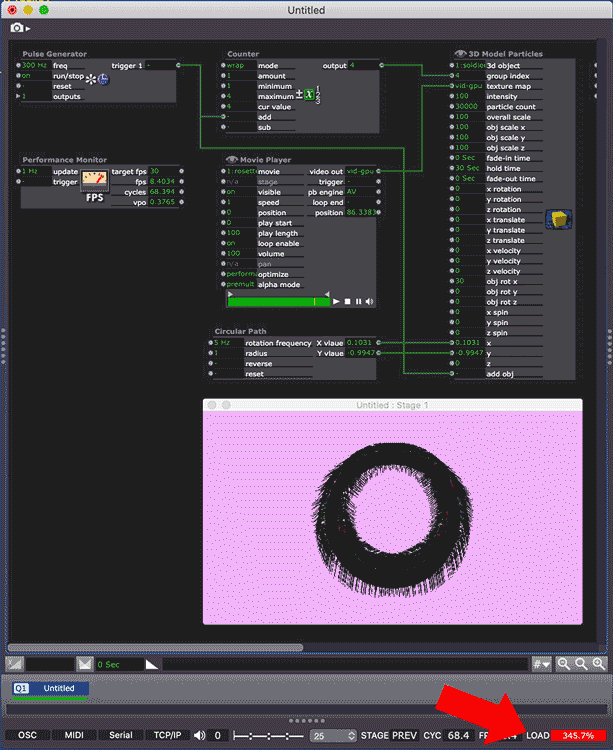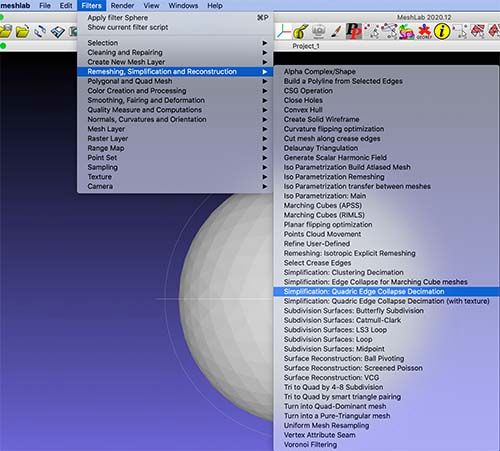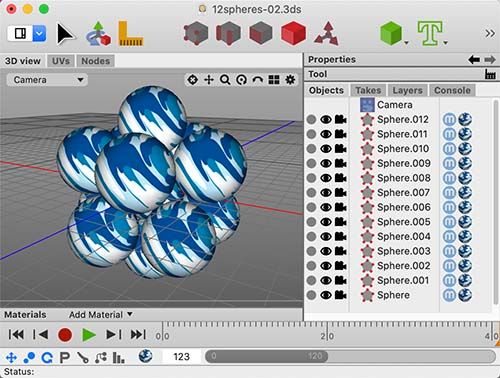Lost sync while recording stage on 25%
-
I have this complicated patch. Different movies, synced by one parent-movie through the position. Those movies project mostly on 3d objects, that are all within one stage-environment. On given percentages there are "camera-moves" or/and "3d model-moves" in the stage with set times (by "ease-in-out-actor"). In three occasions there are, also set on percentages, 3d-particles or 3d-model-particles active, also with external movie-textures. This all drive the load to a minimum of 130% and a maximum of 350%. So I will have to render the video with a 25% setting on recording the stage. The whole scene takes 6'35".
However, the recording messes the timing. Movement and videos and particles really get lost a lot. Really unusable.
Has anybody an idea what I do wrong? How to do it better? Or am I trying to do the impossible? (Sorry but I think the patch is to big, to messy and to complicated to be readable for others but I hope somebody can comment on it in anyway. I'll love to give more info on request.)
By the way, I'm on Macbook pro 2019 with IOS 10.15.7
-
Hi,
It does sound like a bit of the impossible. One thing you could look at is how you are engaging the particles. Reading your description indicates that the parameter properties of 3D Model Particles have a high likelihood of driving up your overall load and potentially disrupting the movie recording.
Your description does not indicate how you are triggering your particles instances, however there are three property inputs of the 3D Model Particles that you might consider moderating to reduce overall load in Isadora. These are 1. the trigger frequency at 'add obj', 2. Particle Count, and 3. 'fade-in time', 'hold time, ' fade-out time'. Moderating these parameter properties will have the biggest effect on the performance.

-
Hai Bonemap,
yes, I knew that it might be asking to much, but with the possibility to render at slower rates I thought (hoped) I could mangae to get a good video. Unfortunately that slow rendering fucks up the timing. Maybe due to different timing sources (video positions/percentages, envelopes, ease in outs and trigger generators to trigger the particles.
And yes, it helps to lower the amount of the particles that exist at te same moment. But artistically that has an lower end, helas.
In the end I might have to render the particles and the rest of the video in different runs and try to get them together in final cut pro. But I still hope that I find a solution for staying in sync in the slow-rendering mode.
All the best, Peter
-
@plem said:
I still hope that I find a solution for staying in sync in the slow-rendering mode
Hi,
I can only speculate based on your description. However, if you are using percentages to compare trigger events and the frame-rate is dropping to something well below the target rate (because of the machines effort to produce 3D model particles), it is not hard to see that there is an inherent performance issue. Here are my suggestions for improving the overall performance by moderating the 3D Model particles:
1. Simplify the 3d model mesh by reducing the number of triangles it contains. You can use an application like MeshLab to decimate the model thereby reducing the load on the computer to calculate the source for each and every triangle of 3D mesh for each and every particle...

2. Then create your mesh geometry using simple shapes in groups/layers so the computer is calculating less position data overall. The 3D Model Particles has an option to read individual elements that are within a single .3DS file, it is the 'group index' parameter. Add a counter that triggers the 'group index' count simultaneously with the 'add obj' trigger to work with this feature. This means each particle appears as one element of rather than a group of elements all at once. Use the principle of 'Sphere of Spheres' to increase the perception of particles based on the position of a parent 3D mesh particle.

This can be very effective when combined with the 'obj rot x', 'obj rot y', 'obj rot z' properties of the 3D Model Particles...

This is also contingent on moderation so limit the number of elements in a mesh group.
A description for creating a sphere of spheres in Blender is here..
3. Synchronise the available rate of particle birth, particle life-span, and particle count so that you find the sweet spot for the overall particle system and its duration (as indicated in the previous thread response).
4. Consider using timecode to compare and trigger the actions as this may work better at the slow render/capture rate required to record the patch output.
Best Wishes
Russell
-
@bonemap said:
4. Consider using timecode to compare and trigger the actions as this may work better at the slow render/capture rate required to record the patch output.
That sounds like an interesting idea. It might change the sync problems for the better so I can have better results while rendering at fi. 25%. I am going to try that!